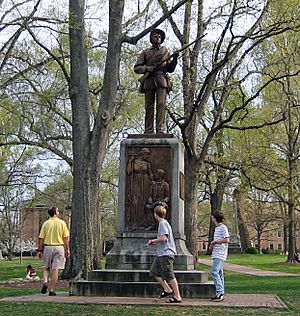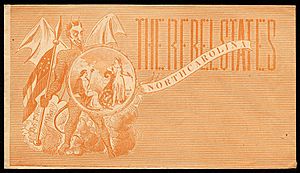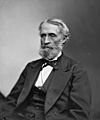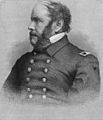North Carolina in the American Civil War facts for kids
Quick facts for kids North Carolina |
|||
|---|---|---|---|
| Nickname(s): "Tar Heel State" | |||
|
|||
| Capital | Raleigh | ||
| Largest City | Wilmington | ||
| Admission to confederacy | May 20, 1861 (10th) | ||
| Population |
|
||
| Forces supplied |
|
||
| Governor | Henry Clark (1861–1862) Zebulon Vance (1862–1865) |
||
| Senators | George Davis (1862–1864) Edwin Reade (1864) William Graham (1864–1865) William Dortch (1862–1865) |
||
| Representatives | List | ||
| Restored to the Union | July 4, 1868 | ||
During the American Civil War, North Carolina joined the Confederacy. This was a difficult decision for the state. Many people in North Carolina wanted to stay with the Union, which was the United States government.
In February 1861, people voted on whether to leave the Union. Those who wanted to stay won, but just barely. However, things changed when President Abraham Lincoln asked for 75,000 soldiers from all Union states. This request made North Carolina feel forced to pick a side.
Like Arkansas, Tennessee, and Virginia, North Carolina had hoped to avoid the war. But Lincoln's call for troops pushed them to join the Confederacy on May 20, 1861.
North Carolina remained a divided state throughout the war. In the Appalachian Mountains in the western part of the state, many people supported the Union. Even so, North Carolina sent many soldiers to fight for the Confederacy. It also helped the Confederacy by sending important supplies through the port of Wilmington. This happened despite the Union blockade, which tried to stop ships from entering Southern ports.
Fighting happened in North Carolina starting in September 1861. Union General Ambrose Burnside captured important ports and cities. These included Roanoke Island and New Bern. In 1864, Confederate forces tried to take back some areas. They temporarily recaptured Plymouth. The Union Army also tried several times to capture Fort Fisher.
The last major Confederate army in the region, led by General Joseph E. Johnston, surrendered in April 1865. This happened at Bennett Place, near Durham, to Union General William Tecumseh Sherman. North Carolina soldiers also fought in many battles in other states. For example, at Gettysburg, soldiers from North Carolina were a big part of Pickett's Charge.
North Carolina also had soldiers who fought for the Union. The 3rd North Carolina Cavalry fought in battles like Battle of Bull's Gap and Battle of Red Banks. They also took part in Stoneman's raids in 1864 and 1865. These raids happened in western North Carolina, southwest Virginia, and eastern Tennessee. The Department of North Carolina was set up in 1862. It helped the Union take Wilmington in 1865. Wilmington was the state's largest city at the time. The XVIII Corps, based in North Carolina, was one of the Union Army's biggest groups.
Contents
Why North Carolina Joined the Confederacy
The great popular heart is not now and never has been in this war. It was a revolution of the politicians, not the people.
—Zebulon Vance, Governor of North Carolina, 1862–1865
In the mid-1800s, North Carolina was a state of differences. The eastern part, called the Coastal Plain, had many large farms called plantations. These farms relied on slavery. In the western part of the state, which was more rural and mountainous, there were very few plantations or enslaved people.
These different views were clear during the election of 1860. North Carolina voted for John C. Breckinridge. He was a Southern Democrat who strongly supported slavery. He wanted slavery to spread to new U.S. territories. Most of the Upper South voted for John Bell, who wanted to keep the Union together.
North Carolina was slow to secede (leave the Union). This was different from most states that voted for Breckinridge. They waited until May 20, 1861. This was after the attack on Fort Sumter in South Carolina. It was also after Virginia, a key Southern state, had already seceded. The very next day, North Carolina officially joined the Confederate States.
Some white North Carolinians did not fully support the Confederacy. These were often farmers who owned few or no enslaved people. They sometimes disagreed with the wealthy plantation owners in the east. Many people avoided being drafted into the army, ran away from the army, or didn't pay taxes. This was especially true in the western part of the state, where many supported the Union.
About 15,000 North Carolinians, including African Americans, joined the Union Army. These Union troops helped take control of areas in the mountains of North Carolina and Tennessee. They also helped in the coastal areas of North Carolina.
At first, the Confederacy tried to stop sending cotton to Europe. They hoped this would force European countries to recognize them as an independent nation. This plan failed. Also, the Union's naval blockade greatly reduced North Carolina's trade by sea. Inside the Confederacy, there were far fewer railroads than in the Union.
The breakdown of the transportation system caused big problems for North Carolina residents. Prices for goods also went up very quickly during the war. Cities faced food shortages. In the spring of 1863, there were even food riots in Salisbury.
Even though there wasn't much fighting in the western mountains, tensions grew. Historians say that in the mountains, different ideas turned into opposing loyalties. These divisions caused as much trouble as any outside army. The mountains became a hiding place for soldiers who ran away, people avoiding the draft, and escaped enslaved people. This made the conflict very personal and harsh.
Major Battles in North Carolina
From September 1861 to July 1862, Union General Ambrose Burnside led the North Carolina Expeditionary Corps. His goal was to capture important ports and cities. He succeeded at the Battle of Roanoke Island and the Battle of New Bern. These victories helped the Union control parts of coastal North Carolina.
Fighting continued in North Carolina throughout the war. In 1864, the Confederates went on the attack. They tried to get back areas Burnside had taken. They failed to retake New Bern. However, they did recapture Plymouth and held it for six months.
The Union Army also made several attempts to capture Fort Fisher. They finally succeeded in 1865. In the last days of the war, a large Union force led by General William Tecumseh Sherman marched into North Carolina. This was part of the Carolinas Campaign. Sherman's army took control of much of the state. They defeated the Confederates in key battles, including Averasborough and Bentonville.
The surrender of General Joseph E. Johnston's Confederate army at Bennett Place in April 1865 basically ended the war in the eastern United States.
Key Battles Fought in North Carolina
Here are some of the major Civil War battles that took place in North Carolina:
| Battle | Date | Location | Outcome |
|---|---|---|---|
| Battle of Albemarle Sound | May 5, 1864 | Albemarle Sound | Inconclusive |
| Battle of Averasborough | March 16, 1865 | Harnett and Cumberland Counties | Inconclusive |
| Battle of Bentonville | March 19–21, 1865 | Johnston County | Union victory |
| Battle of Fort Anderson | March 13–16, 1863 | Craven County | Union victory |
| Battle of Fort Fisher I | December 23–27, 1864 | New Hanover County | Confederate victory |
| Battle of Fort Fisher II | January 13–15, 1865 | New Hanover County | Union victory |
| Siege of Fort Macon | March 23, 1862 – Apr 26, 1862 | Carteret County | Union victory |
| Battle of Goldsborough Bridge | December 17, 1862 | Wayne County | Union victory |
| Battle of Hatteras Inlet Batteries | August 28–29, 1861 | Outer Banks | Union victory |
| Battle of Kinston | December 14, 1862 | Lenoir County | Union victory |
| Battle of Monroe's Cross Roads | March 10, 1865 | Hoke County | Inconclusive |
| Battle of Morrisville | April 13–15, 1865 | Wake County | Union victory |
| Battle of New Bern | March 14, 1862 | Craven County | Union victory |
| Battle of Plymouth | April 17–20, 1864 | Washington County | Confederate victory |
| Battle of Roanoke Island | February 7–8, 1862 | Dare County | Union victory |
| Battle of South Mills | April 19, 1862 | Camden County | Confederate victory |
| Battle of Tranter's Creek | June 5, 1862 | Pitt County | Union victory |
| Battle of Washington | March 30, 1863 – April 20, 1863 | Beaufort County | Inconclusive |
| Battle of White Hall | December 16, 1862 | Wayne County | Draw |
| Battle of Wilmington | February 11–22, 1865 | New Hanover County | Union victory |
| Battle of Wyse Fork | March 7–10, 1865 | Lenoir County | Tactical Union victory, Strategic Confederate victory |
| Campaign of the Carolinas | January 1 – April 26, 1865 | North and South Carolina | Decisive Union victory |
North Carolina's Government During the War
Henry Toole Clark was North Carolina's governor from July 1861 to September 1862. He started a Confederate prison in the state. He also helped set up ways to buy supplies from Europe. Clark built a successful factory to make gunpowder.
His successor, Zebulon Vance, became governor in 1862. Vance increased the state's help for soldiers fighting in the war.
As the war continued, William Woods Holden became a quiet critic of the Confederate government. He led a peace movement in North Carolina. In 1864, he ran for governor against Vance, but he lost.
Union supporters in North Carolina formed a group called the "Heroes of America." This group was allied with the United States. They had almost 10,000 members, some of whom might have been Black. They helped Southern Unionists escape to Union lines.

The North Carolina General Assembly (the state's lawmaking body) approved the Fourteenth Amendment on July 4, 1868. This action allowed North Carolina to rejoin the Union.
North Carolina After the Civil War
After the Civil War ended, North Carolina was part of the Second Military District. Major General John M. Schofield was the military leader in charge for about a month. He worked to help the state recover and provide aid to its people.
On May 29, 1865, President Andrew Johnson named William W. Holden as the temporary governor of North Carolina. President Johnson's plan allowed North Carolina to hold a special meeting to rejoin the Union. This meeting had to declare that leaving the Union was invalid. It also had to end slavery and require people to take an oath of loyalty.
There was still a military governor, Brigadier General Thomas H. Ruger. He replaced Schofield and worked with Holden. For example, he helped remove most African American soldiers from North Carolina. On July 22, 1868, after other military leaders had served, military control over North Carolina ended. This marked the end of military reconstruction for North Carolina.
Images for kids
-
General
Braxton Bragg -
Lt. Gen.
Leonidas Polk -
Maj. Gen.
D. H. Hill -
Maj. Gen.
Stephen Dodson Ramseur -
Brig. Gen.
Lewis A. Armistead -
Brig. Gen.
Lawrence O. Branch -
Brig. Gen.
Robert D. Johnston -
Brig. Gen.
James Green Martin -
Brig. Gen.
John Gibbon -
Unionist
William Woods Holden -
President
Andrew Johnson -
Brig. Gen.
Solomon Meredith
See also
- Campaign of the Carolinas
- List of American Civil War battles
- List of North Carolina Confederate Civil War units
- List of North Carolina Union Civil War regiments
- History of slavery in North Carolina




































